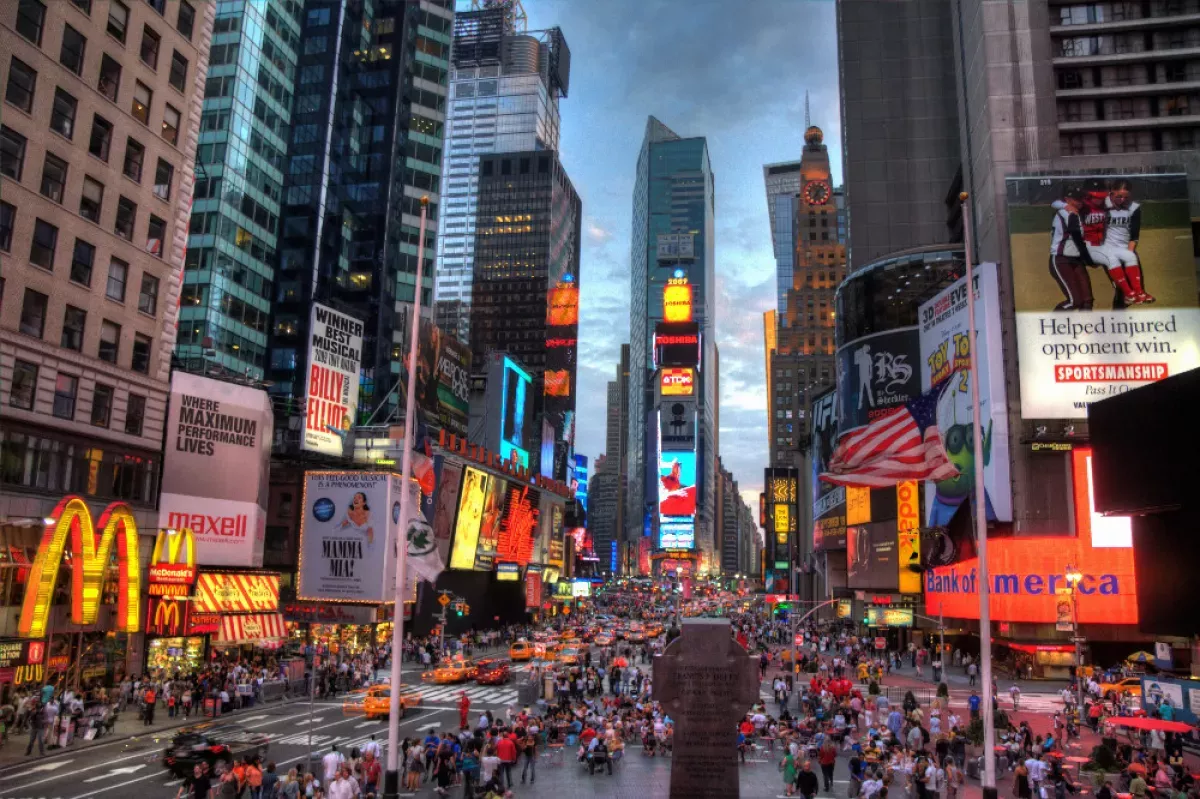Times Square, a vibrant intersection in Midtown Manhattan, New York City, is a global hub for commerce, tourism, and entertainment. Characterized by its bowtie shape, it spans five blocks along Broadway, Seventh Avenue, and 42nd Street, extending to 47th Street with Duffy Square. Renowned for its dazzling lights and bustling atmosphere, Times Square is a must-see destination showcasing the city's dynamic energy.
April 8, 1904: First Electric Sign in Times Square
Just three weeks after Times Square got its new name, the first electrified advertisement illuminated the area, marking a pivotal moment in the history of Times Square's iconic signage.
1904: Times Square is Named
Longacre Square was renamed "Times Square" in 1904 after the New York Times moved its headquarters to the newly built Times Building in the square.
1904: First New Year's Eve Fireworks Display
Times Square's New Year's Eve celebrations began in 1904 with an extravagant fireworks show launched from the top of One Times Square, a tradition that lasted until 1906.
1906: End of Fireworks, Beginning of Ball Drop Tradition
Due to fire hazards, the tradition of New Year's Eve fireworks display in Times Square ended in 1906, paving the way for the iconic ball drop ceremony.
December 31, 1907: First New Year's Eve Ball Drop
The inaugural New Year's Eve ball drop took place in Times Square, drawing a large crowd and marking the beginning of a beloved annual tradition.
1908: Artkraft Strauss Takes Over Ball Drop
Starting in 1908, Artkraft Strauss, a renowned Times Square sign maker, assumed the responsibility of managing the New Year's Eve ball drop, a role they held for over eight decades.
1910: American Horse Exchange Becomes Winter Garden Theatre
The American Horse Exchange, a prominent feature of Longacre Square, was transformed into the Winter Garden Theatre in 1910.
1911: Winter Garden Theatre Constructed
The Winter Garden Theatre, built on the site of the former Horse Exchange, was constructed in 1911.
1913: Lincoln Highway Eastern Terminus
The Lincoln Highway Association designated the intersection of 42nd Street and Broadway as the eastern terminus of the Lincoln Highway, the first transcontinental road across the United States, in 1913.
1913: New York Times Moves Offices
The New York Times relocated to a larger office space a block west of Times Square in 1913.
1923: Fritz Lang Inspired by Times Square
Filmmaker Fritz Lang visited Times Square in 1923, drawing inspiration from its vibrant and bustling atmosphere for his iconic film "Metropolis."
May 1937: Duffy Statue Dedicated
A statue by Charles Keck, serving as a memorial to Father Duffy, was dedicated in May 1937.
June 1939: Duffy Square Dedicated
The northern triangle of Times Square was officially named Duffy Square in June 1939, honoring World War I chaplain Father Francis P. Duffy.
1942: Ball Drop on Hiatus
Due to wartime lighting restrictions during World War II, the traditional New Year's Eve ball drop was put on hold in 1942.
1943: Ball Drop Still on Hiatus
The New Year's Eve ball drop remained on hold in 1943 due to ongoing wartime lighting restrictions.
May 8, 1945: Victory in Europe Day Celebrated
Times Square witnessed a massive celebration on May 8, 1945, as crowds gathered to mark Victory in Europe Day.
August 15, 1945: Victory over Japan Day Celebrated
The largest crowd in Times Square's history, estimated at two million people, assembled to celebrate Victory over Japan Day on August 15, 1945.
August 1945: End of World War II Celebrations
In August 1945, Times Square became the epicenter of massive celebrations marking the end of World War II, drawing enormous crowds to the area.
1960: 42nd Street Declines
By 1960, the area around 42nd Street began experiencing a decline, with concerns about crime and seediness arising.
1961: New York Times Sells Old Building
The New York Times sold their former headquarters building in 1961.
1963: Old Times Building Renamed
The former New York Times Building was renamed the Allied Chemical Building in 1963.
1969: Times Square in "Midnight Cowboy"
The gritty and seedy side of Times Square was prominently featured in the 1969 film "Midnight Cowboy," portraying the area's social landscape during that era.
1971: Times Square in "Born to Win"
In 1971, the film "Born to Win" continued to showcase Times Square's reputation for seediness, further cementing its image as a place of urban decay in popular culture.
June 1973: TKTS Booth Opens
The TKTS discount ticket booth, offering same-day Broadway and off-Broadway tickets, opened in Times Square in June 1973.
1976: Times Square in "Taxi Driver"
The 1976 film "Taxi Driver" further cemented Times Square's association with urban blight, using the area's gritty atmosphere to enhance the film's themes.
1980: Times Square in "Times Square"
The 1980 film "Times Square" used the area as its backdrop, capturing its gritty atmosphere and featuring a punk rock/new wave soundtrack that reflected the era's cultural landscape.
1981: 42nd Street Called "Sleaziest Block in America"
An article in Rolling Stone magazine labeled 42nd Street in Times Square as the "sleaziest block in America" in 1981.
1981: Redevelopment Plan Proposed
The Empire State Development Corporation put forward a proposal in 1981 to redevelop the area surrounding a section of West 42nd Street.
1982: West Midtown Special Zoning District Created
The establishment of the West Midtown special zoning district in 1982 by the New York City government allowed for the development of new buildings in Times Square with an increased floor area ratio.
1984: Low Property Taxes Reflect Decline
The Times Square area faced significant challenges in 1984, with the extent of its decline reflected in the remarkably low property taxes collected, amounting to only $6 million.
1984: High Crime Rates
The area surrounding Times Square grappled with high crime rates, with the block of 42nd Street between Seventh and Eighth avenues recording 2,300 crimes in 1984.
1986: Prudential Joins Redevelopment Project
Prudential Insurance Company of America became a partner in the West 42nd Street redevelopment project in 1986.
1986: New Building Regulations Considered
The New York City Planning Commission explored the implementation of regulations that would mandate bright signage and setbacks for new constructions in Times Square in 1986.
1987: Zoning Ordinance Mandates Illuminated Signs
In 1987, zoning ordinances mandated building owners in Times Square to display illuminated signs.
1987: Planning Regulation Adopted
The New York City Planning Commission formally adopted a planning regulation in 1987, requiring new large-scale developments in Times Square to allocate a portion of their space for entertainment purposes and incorporate prominent signage.
1990: New York State Takes Control of Times Square Theaters
In 1990, the State of New York took possession of six theaters on 42nd Street and appointed the New 42nd Street non-profit to oversee their restoration and maintenance.
1992: Prudential and Park Tower Postpone Development
Opposition to proposed towers and difficulty securing tenants led to Prudential and Park Tower postponing their Times Square project in 1992. In exchange for a delay until 2002, they were required to make improvements to existing buildings.
1992: Times Square Alliance Begins Operations
The Times Square Alliance, aimed at improving commerce and cleanliness, began operating in the area in 1992.
1992: Bertelsmann Purchases 1540 Broadway
The entertainment conglomerate Bertelsmann acquired the building at 1540 Broadway in 1992, signaling a potential turning point in the revitalization of Times Square.
1992: Introduction of Biodegradable Confetti
The year 1992 marked the beginning of a new tradition in Times Square's New Year's Eve festivities—the dropping of 3,000 pounds of biodegradable confetti at midnight.
1993: Morgan Stanley Purchases 1585 Broadway
Financial firm Morgan Stanley's purchase of the property at 1585 Broadway in 1993 further contributed to the momentum of Times Square's revival.
1993: Signage Ordinance Implemented as Part of Revitalization
The signage ordinance in Times Square, requiring illuminated signs, was implemented in 1993 as part of Governor Mario Cuomo's revitalization program.
1994: Morgan Stanley Purchases 750 Seventh Avenue
Morgan Stanley's acquisition of 750 Seventh Avenue in 1994 solidified the trend of major financial institutions investing in Times Square, bolstering its resurgence.
1996: Changes in Ownership and Development at Times Square
Prudential and Klein dissolved their partnership, and Douglas Durst acquired a site on 42nd Street in 1996.
1998: Klein, Blackstone, and Boston Properties Acquire Sites
A joint venture of Klein, The Blackstone Group, and Boston Properties acquired sites at 42nd Street and Seventh Avenue in 1998.
1998: Times Square in "Godzilla"
In the 1998 film "Godzilla," Times Square is depicted as a battleground when the monstrous creature wreaks havoc on the city, showcasing the area's vulnerability to large-scale destruction.
1998: Times Square Tourist Information Center Opens
The Times Square Alliance opened a tourist information center in the former Embassy Theatre in 1998.
December 31, 1999: Millennium Celebration in Times Square
On December 31, 1999, Times Square witnessed an unprecedented turnout of approximately two million people for the millennium celebration, marking the largest gathering in the area since the end of World War II in August 1945.
2001: 3 Times Square Opens
Reuters, with development partner Rudin Management, completed 3 Times Square in 2001.
2002: 5 Times Square Opens
5 Times Square, on the southwest corner of 42nd Street and Seventh Avenue, was completed in 2002.
2002: Bloomberg's Inauguration at Times Square
Michael Bloomberg was sworn in as mayor of New York City at Times Square on January 1, 2002, as part of the New Year's celebration.
2002: Times Square in "Spider-Man"
The 2002 superhero film "Spider-Man" features Times Square during a vibrant festival scene, highlighting the area's energy and spectacle.
2002: "Mind Over Madness" Yoga Event Begins
The annual "Mind Over Madness" mass yoga event, marking the summer solstice, began in Times Square in 2002.
2004: Times Square Tower Opens
Times Square Tower, on the southeast corner of 42nd Street and Seventh Avenue, opened in 2004.
December 4, 2008: Times Square's First Eco-Friendly Billboard Lit
Times Square's first environmentally friendly billboard, powered by wind and solar energy, was illuminated on December 4, 2008.
2008: Debut of the Energy-Efficient LED Ball
In 2008, a new era dawned for the Times Square ball drop as a more sustainable and dazzling energy-efficient LED ball was introduced, commemorating the centennial of the tradition.
February 26, 2009: Traffic Lanes on Broadway to be Transformed into Pedestrian Plazas
Mayor Bloomberg announced the closure of traffic lanes on Broadway from 42nd to 47th Street to create pedestrian plazas, starting Memorial Day 2009.
August 14, 2009: Temporary Seating in Times Square Plaza Removed
The initial multicolored plastic lawn chairs used as temporary seating in the Times Square plaza were removed on August 14, 2009.
2009: Times Square Valentine's Day Heart Tradition Starts
The tradition of the Times Square Valentine's Day heart began in 2009, with a design by architect Mark Foster Gage.
February 11, 2010: Times Square Pedestrian Plazas Made Permanent
Mayor Bloomberg announced that the pedestrian plazas in Times Square would become permanent on February 11, 2010.
2010: Reconstruction of Times Square Plaza Begins
Reconstruction of the Times Square plaza, with granite pavers and benches, began in 2010.
February 2011: Times Square Becomes Smoke-Free
In February 2011, New York City extended its outdoor smoking ban to Times Square.
2011: Times Square in "New Year's Eve"
The romantic comedy "New Year's Eve," released in 2011, featured Times Square as a prominent location, showcasing its energy and excitement during the iconic New Year's Eve celebrations.
March 2012: Times Square's Record-Breaking Attendance
Between March 2012 and February 2013, Times Square experienced an extraordinary influx of visitors, surpassing even Disney theme parks globally, with a staggering 128,794,000 people.
February 2013: End of Times Square's Record-Breaking Year
By February 2013, Times Square concluded a year of unprecedented visitor numbers, solidifying its position as a global tourist hotspot.
December 2013: First Phase of Times Square Plaza Completed
The first phase of the renovated Times Square pedestrian plaza was completed in December 2013.
February 1, 2014: Super Bowl Boulevard Takes Over Times Square
A "Super Bowl Boulevard" with activities and attractions was held on Broadway in Times Square leading up to Super Bowl XLVIII in February 2014.
2014: Massive Cleanup After New Year's Eve
On New Year's Day 2014, the New York City Department of Sanitation, along with the Times Square Alliance, undertook a massive cleanup effort, clearing over 50 tons of trash left behind from the previous night's festivities.
2015: Controversy Over Topless Women and Panhandling Characters
During the summer of 2015, Times Square saw a surge in controversy due to the significant presence of topless women known as "desnudas" and panhandling costumed characters, sparking debates about their impact on the area's quality of life.
June 2016: Pedestrian Flow Zones Implemented
In June 2016, in an attempt to regulate the crowds in Times Square, "pedestrian flow zones" where loitering was prohibited were put in place, along with designated "activity zones" for costumed performers.
2016: Times Square Pedestrian Plaza Project Completed
The entire Times Square pedestrian plaza project was completed just before New Year's Eve 2016.
2017: Calls for Increased Safety Bollards
Following a vehicle-ramming attack in 2017, there were calls to install more safety bollards in Times Square.
October 2020: Impact of the COVID-19 Pandemic on Times Square
By October 2020, the COVID-19 pandemic significantly impacted Times Square, leading to the closure of numerous hotels, stores, and restaurants, and a drastic reduction in pedestrian traffic.
2020: Increased Security Measures for New Year's Eve
For the 2020 New Year's Eve celebration, which drew a million attendees, heightened security measures were implemented, including aluminum barriers spanning from 38th to 59th Street and Sixth to Eighth Avenue.
2021: Closed New Year's Eve Celebration
As a result of the ongoing pandemic, Times Square was closed to the public for New Year's Eve 2021, with limited observers placed in designated enclosures to ensure social distancing.
October 2022: Proposal for Times Square Casino Submitted
In October 2022, a proposal was submitted to open a casino at 1515 Broadway in Times Square.
Mentioned in this timeline

Michael Bloomberg is an American entrepreneur politician and philanthropist He...
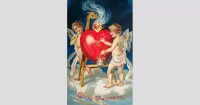
Valentine's Day observed annually on February th began as a...
Japan is an East Asian island country situated in the...
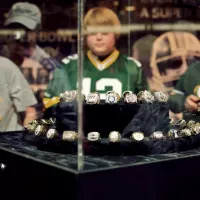
The Super Bowl is the annual championship game of the...
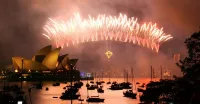
Fireworks are pyrotechnic devices primarily utilized for entertainment and aesthetic...
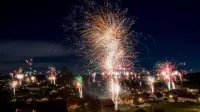
New Year's Eve observed on December st marks the final...
Trending

42 minutes ago Stranger Things cast reflects on the final season and saying goodbye.

42 minutes ago Bella Hadid stuns in daring Orebella ad and sheer floral dress.
42 minutes ago Ukraine and U.S. to meet in Switzerland regarding Trump's peace plan with Russia.
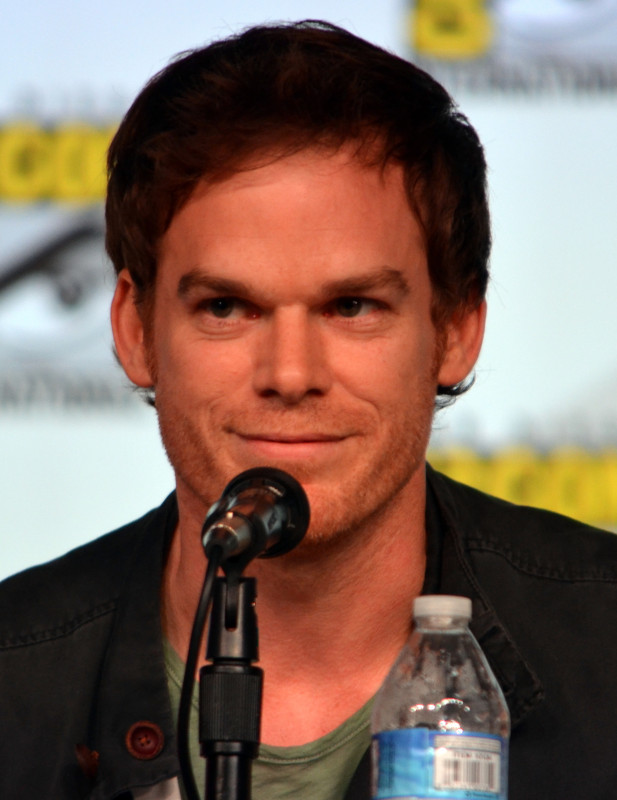
43 minutes ago Michael C. Hall rumored as Brainiac in James Gunn's new DCU Superman movie.

43 minutes ago Billie Eilish's 'Hit Me Hard and Soft' 3D Concert Film Coming to Theaters
43 minutes ago Eddie Murphy regrets declining 'Rush Hour'; Trump aims to remake culture with it.
Popular

William Franklin Graham III commonly known as Franklin Graham is...

XXXTentacion born Jahseh Dwayne Ricardo Onfroy was a controversial yet...
Aftyn Alyssa Behn is an American politician currently serving as...

Marjorie Taylor Greene known as MTG is a U S...

Candace Owens is an American conservative political commentator and author...

Cristiano Ronaldo often nicknamed CR is a Portuguese professional footballer...
